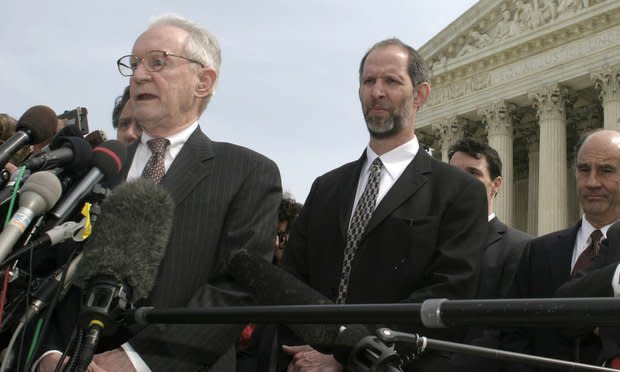In Early Rulings, Gibbons Informed by Faith, Compassion

John Gibbons Jr. in front of the U.S. Supreme Court after arguing the Guantanamo cases. Photo by Roberto Westbrook
The career of John Gibbons Jr., former chief judge of the U.S. Court of Appeals for the Third Circuit, was remarkable for the many roles he held—firm leader, judge, professor and death penalty opponent.
Gibbons, who died at age 94 on Dec. 9, spent 20 years as a judge on the Third Circuit. A review of his judicial career shows he regularly took heat for positions that others saw as too progressive.
Gibbons was appointed to the appeals court by President Richard Nixon in December 1969 and retired in 1990, filling the position of chief judge from 1987 to 1990. He was president of the New Jersey State Bar Association in 1967 and 1968 and was named by Gov. Richard Hughes to serve on a panel that was formed to study the causes of the 1967 riots in Newark. The study panel was known as the Lilley Commission for its chairman, Robert Lilley.
After leaving the bench, Gibbons taught full time at Seton Hall University School of Law, and rejoined the Newark firm then known as Crummy, Del Deo, Dolan, Griffinger & Vecchione, where he had practiced before receiving his judicial appointment. To mark his return, the firm established the John J. Gibbons Fellowship in Public Interest and Constitutional Law in 1990, dedicating two full-time attorneys to undertake public interest and constitutional law projects and litigation on a pro bono basis.
The firm later became known as Gibbons, Del Deo, Dolan, Griffinger & Vecchione, and then simply Gibbons in 2007.
In 2004, Gibbons argued before the U.S. Supreme Court to oppose the detention, without judicial review, of prisoners incarcerated at the Guantánamo Bay Naval Base. The court decided in favor of the detainees.
Gibbons' commitment to the underprivileged was evidence in his earliest judicial endeavors, even as he sometimes faced a backlash for his views.
Gibbons' involvement in the Lilley Commission became an issue in 1972 after he ruled in favor of a congressional reapportionment plan creating a majority-black district for Newark in David v. Cahill. Assigned to a three-judge U.S. District Court panel, as was common practice at that time for state constitutional issues, Gibbons, joined by District Judge Leonard Garth, approved a redistricting plan that included a district encompassing Newark, East Orange, Glen Ridge and Harrison.
The plan called for municipal boundaries to be left intact, and replaced one in which Newark was divided between two congressional districts. The dissenter, Judge Clarkson Fisher, argued that the court should not consider race when drawing boundaries of congressional districts.
The decision "was expected to pave the way eventually for a significant milestone in New Jersey's social history—the election of the state's first black congressman," said an Associated Press article from April 1972.
Indeed, the district in question, long represented by Peter Rodino Jr., elected Donald Payne to Congress in 1998, and he served there until his death in 2012.
But in light of Gibbons' involvement in the Commission on Civil Disorders, his ruling in the reapportionment case "stirred discussion among legal observers, including some who question whether Gibbons' presence on the court poses 'a conflict of interest,'" the Associated Press article said.
Gibbons again came under criticism in the mid-1970s when he was designated to preside over a three-judge District Court panel hearing Evans v. Buchanan, a long-running case in the District of Delaware that concerned desegregation of schools in Wilmington and surrounding areas.
Serving on a panel along with two District Court judges from Delaware who were on senior status, he favored a desegregation plan that encompassed suburban areas, while one of his colleagues sought to limit desegregation to Wilmington.
Gibbons was viewed by Delawareans as a liberal who had preconceived notions about the proper remedy on the segregation issue, and the state's governor and attorney general called for his removal from the case, while anti-busing groups made him "a symbol of their disdain for the court," the Wilmington News-Journal reported in 1976.
Later, Gibbons was the dissenter in Vorchheimer v. School District of Philadelphia, a Third Circuit ruling from 1976 in which a female student sought admission to all-male Central High School. Susan Vorchheimer claimed that Central was more academically rigorous than its all-female counterpart in the Philadelphia district, Girls High. The panel upheld the school district's admissions policy by a 2-1 margin, and the U.S. Supreme Court later upheld that position.
Gibbons, noting that co-education at the high school level has its supporters and detractors, said that nonetheless "some showing must be made that a single-sex academic high school policy advances the Board's objectives in a manner consistent with the requirements of the Equal Protection Clause."
Gibbons "saw something that was wrong and he wanted to make it right," said Ronald Riccio, dean emeritus of Seton Hall University School of Law, who was Gibbons' colleague at the school. "It wasn't based on ideology, it was based on right and wrong."
After leaving the bench, Gibbons was "very humble … never exhibited any kind of ego" and "never sought any privileges or preferences," said Riccio. He developed a strong sense of faith while attending St. Benedict's Preparatory School in Newark, an all-boys high school, and later he was known to attend mass nearly every day, Riccio said.
Gibbons "did what he thought was right based on the facts and the law and at the same time he had tremendous compassion for people who were underprivileged," Riccio recalled.


